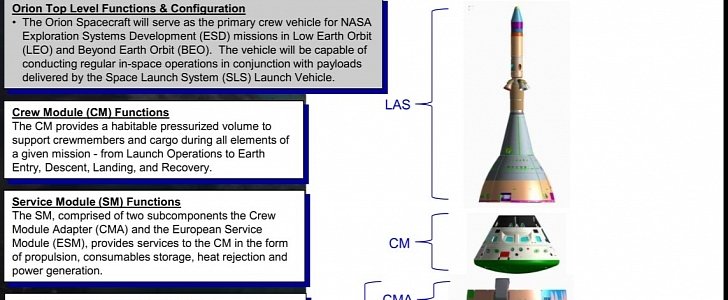As the eyes of the world look forward to next year's first crewed flights to space to take off from U.S. soil in years, what comes to mind when thinking about the spacecraft involved are SpaceX's Crew Dragon and Boeing's Starliner.
But NASA is working on a spacecraft of its own, one it calls Orion. The ship just got its engine delivered from Europe in November, and about a month after that managed to pass a critical review that opens to road to the first launch.
NASA's plan for Orion is to have it depart Earth uncrewed in the so-called Exploration Mission-1 (EM-1). This flight is to take the spacecraft at about 280,000 miles away from Earth (450,000 km), well past our Moon, on a three-week-long journey.
If all goes well during the test, the crewed Exploration Mission 2 (EM-2) will follow sometime in 2022 or 2023. With people on board, the ship will do a highly elliptical demonstration run around the world and then, boosted by the engine delivered from Europe, head for the Moon, without landing there. The mission is expected to last for a minimum of eight days
The December Critical Design Review (CDR) was meant to highlight the needed hardware changes between the uncrewed and crewed missions. Those doing the review found most of the changes to be in line with what the builders and operators of the spacecraft were hoping for.
“The vehicle came through very well on this CDR,” said according to NASA Spaceflight Mark Kirasich, Orion program manager. “This CDR was focused on the differences between EM-1 and EM-2, which primarily is in two areas. The ECLSS, the Environmental Control and Life Support System, and the crew displays.”
“Those two systems came through very clean, very few problems because predominantly the teams — even though we don’t fly them on EM-1 — we’ve been working them hard offline in labs and risk reduction development testing,”
The official says there were 206 changes made in the configuration of the ship when comparing the craft for the first flight to the one for the second, and the board in charge with analyzing them looked at 37 by December. The rest should be looked into by May when the program's leaders are scheduled to meet again.
You can have a look at some of the changes engineers are calling for at this link.
NASA's plan for Orion is to have it depart Earth uncrewed in the so-called Exploration Mission-1 (EM-1). This flight is to take the spacecraft at about 280,000 miles away from Earth (450,000 km), well past our Moon, on a three-week-long journey.
If all goes well during the test, the crewed Exploration Mission 2 (EM-2) will follow sometime in 2022 or 2023. With people on board, the ship will do a highly elliptical demonstration run around the world and then, boosted by the engine delivered from Europe, head for the Moon, without landing there. The mission is expected to last for a minimum of eight days
The December Critical Design Review (CDR) was meant to highlight the needed hardware changes between the uncrewed and crewed missions. Those doing the review found most of the changes to be in line with what the builders and operators of the spacecraft were hoping for.
“The vehicle came through very well on this CDR,” said according to NASA Spaceflight Mark Kirasich, Orion program manager. “This CDR was focused on the differences between EM-1 and EM-2, which primarily is in two areas. The ECLSS, the Environmental Control and Life Support System, and the crew displays.”
“Those two systems came through very clean, very few problems because predominantly the teams — even though we don’t fly them on EM-1 — we’ve been working them hard offline in labs and risk reduction development testing,”
The official says there were 206 changes made in the configuration of the ship when comparing the craft for the first flight to the one for the second, and the board in charge with analyzing them looked at 37 by December. The rest should be looked into by May when the program's leaders are scheduled to meet again.
You can have a look at some of the changes engineers are calling for at this link.

